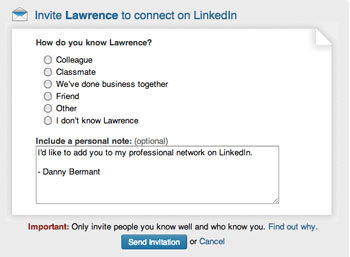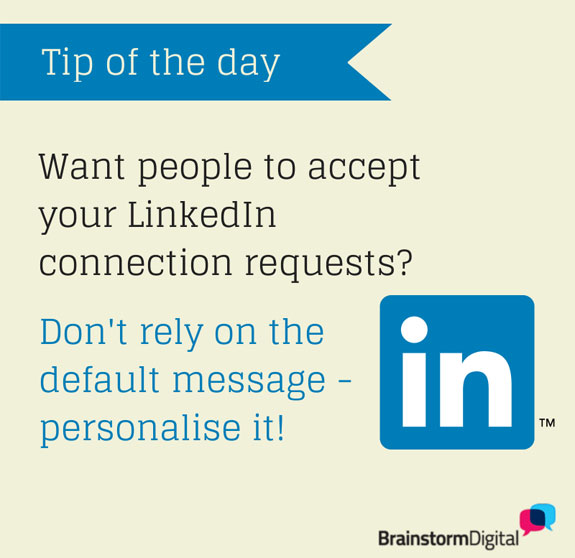 Last month, Diana Mekota, a young American job seeker tried to connect on LinkedIn with Kelly Blazek, head of the Cleveland Job Bank. The response from Blazek has now gone viral.
Last month, Diana Mekota, a young American job seeker tried to connect on LinkedIn with Kelly Blazek, head of the Cleveland Job Bank. The response from Blazek has now gone viral.
She attacked Mekota, “a total stranger who has nothing to offer me”, of trying to access her LinkedIn connections, decried “the sense of entitlement in your generation,” and said that she enjoyed turning down her request on LinkedIn, as well as her request to join the job bank.
“I suggest you join the other job bank in town,” she wrote. “Oh wait – there isn’t one.
“You’re welcome for your humility lesson for the year.”
Inevitably, the one who received the humility lesson was Blazek herself, as Mekota posted the entire message online, and Blazek was practically forced into hiding.
What had Mekota written to justify such an avalanche of hostility? Nothing more than a polite reiteration of her qualifications, it seems.
But amid the general horror at Blazek’s nasty tone, an important point has got lost, and that is that there is a right way and a wrong way to ask strangers for a LinkedIn connection.
I have particular insight into this right now because, after I posted a link to the Blazek story on LinkedIn, it too went viral, generating more than 600 comments in three days. As I result, I have been inundated with LinkedIn connection requests – more than 30 today alone. Of these, I have accepted exactly….. one, and am still considering three others.
(Don’t worry, I’m not going to send rude responses to the people I don’t accept!).

So what gets your LinkedIn connection requests read and considered – and what gets them automatically deleted? Here are some guidelines for success:
- Have a reason for connecting. I don’t believe you have to personally know everyone you connect to on LinkedIn. But you do need to have a good reason for suggesting a connection.These include wanting to do business together, seeking advice, having something in common, having something to offer them, or having developed a rapport on LinkedIn groups or another social media platform.There needs to be some logic in the link. If you own a shoe shop in Manchester,for example, there is unlikely to be any benefit to either party if you suggest a link to an IT professional in New Zealand, or a television engineer in London. And yet people do, the whole time, because they came across the other profile somehow, or just want to look like they have a lot of connections.Don’t waste their time – or yours.
- State that reason. The person you want to connect to is not a mind-reader. If you have a genuine reason to connect to them, you need to spell it out so they are clear why your connection request is worth considering.The request I did accept today clearly stated that they might have some work for me.Is this necessarily true? I have no idea! But amongst 30 other almost identical, bland requests, it stood out.
Example: “Dear David, I understand that you own a shoe shop and think there might be some synergy with my own business, which is importing sports shoes from China. It would be great if we could connect and have a chat.”
- Never, ever use the standard request template“Hi Miriam, I’d like to connect with you on LinkedIn.”If you are using the text that LinkedIn provides in order to connect – as the vast majority of people do – you are at a severe disadvantage.
First of all, your message reads exactly like everyone else’s. Second, you are sending the message that the connection request is not even that important to you – after all, you couldn’t be bothered to spend 10 seconds changing it. Third, you have given the recipient who doesn’t know you no reason whatsoever to connect with you.It is essential that you personalise your message. It’s fine to state that you enjoyed something they wrote and would like to discuss it further; or that you have groups and interests in common; or that you would value their insight on a particular topic. But put some thought into it.
Example: “Dear David, I see that we both run businesses in Hale and that we are both members of the SMEs in Manchester LinkedIn group. Perhaps we can connect on LinkedIn? We probably face many similar business challenges and it would be great to swap notes.”
 Put yourself in context. Do you know your potential contact just a little bit – perhaps you met them at a conference that day, or took a course together several years ago? Remind them. Don’t assume they remember you.Example: “Dear David, it was a pleasure meeting you last week at Johnny’s barbecue. I very much enjoyed our conversation about the challenges of running a small business and would love to follow up with you. Let’s connect on LinkedIn.”
Put yourself in context. Do you know your potential contact just a little bit – perhaps you met them at a conference that day, or took a course together several years ago? Remind them. Don’t assume they remember you.Example: “Dear David, it was a pleasure meeting you last week at Johnny’s barbecue. I very much enjoyed our conversation about the challenges of running a small business and would love to follow up with you. Let’s connect on LinkedIn.”- Butter people up. What were the other three messages that stood out for me today? One told me that we were graduates of the same university, and that they were proud that a fellow alum was getting attention on LinkedIn. Two others told me how much they enjoyed the story and thanked me for posting it.OK, so I haven’t accepted them yet. But I haven’t deleted them yet either.Flattery will get you quite a lot of places. It’s human nature, especially when you are essentially asking people for a favour by connecting with you. You need to sweeten them up a little (but not too much. Don’t sound insincere).
Example: “Dear Michelle, I came across the brochure you produced for the University of Watford and thought it was really wonderful. Well done! My own business may need some design work in the future, I would be delighted if we could connect on LinkedIn.”
- Show that you’ve read their profile. Another way of personalising your message, showing that you have put some time into it, and that this is a connection you will really value. But only do this if appropriate.Messages picking out random biographical facts are less likely to impress than those showing that you have watched their video or learned from their Slideshare. Example:“Dear Michelle, I just wanted to tell you how much I loved the slideshow of designs on your profile, especially the cover of the brochure you produced for the University of Watford. It was really powerful. My own company may need some design work in the future, I would be delighted if we could connect on LinkedIn.”
- Tell them what’s in it for them. If you can read Kelly Blazek’s message without getting distracted by its incredibly nastiness, she actually has a point. Why should she connect to someone when only one party is going to get something out of it – and that’s not her?Make sure that your connection request is focused on the benefit for the other person, and not for you.Do NOT tell an up-and-coming author that you need them on your webinar to ensure that it is a success. Tell them that you have would be honoured to have them on your webinar, which will be broadcast to several thousand people, and that there will be several opportunities for them to plug their book.Now who would turn down a request like that?
Example: “Dear Johnny, I love your blog on running a small business and have some ideas from my own experience that might make good posts. I would love to share them with you – can we connect on LinkedIn?”
- Be polite. This should hardly need saying, but the case of Kelly Blazek shows that sometimes it does. A request thanking your potential connection for their time will take you further than one that badgers them to accept.Example: “Dear Johnny, I love your blog on running a small business and have some ideas from my own experience that might make good posts. I would love to share them with you – can we connect on LinkedIn? Thank you in advance for your time and consideration.”
What are your tips and tricks for making great connections on LinkedIn? Tell us in the comments!
Miriam Shaviv is director of content at Brainstorm Digital.
If you liked this post, you might enjoy:
- Are you missing these 7 ways to find leads on LinkedIn?
- 10 people just connected to me on LinkedIn… Now what?
- 9 features that would dramatically improve LinkedIn




